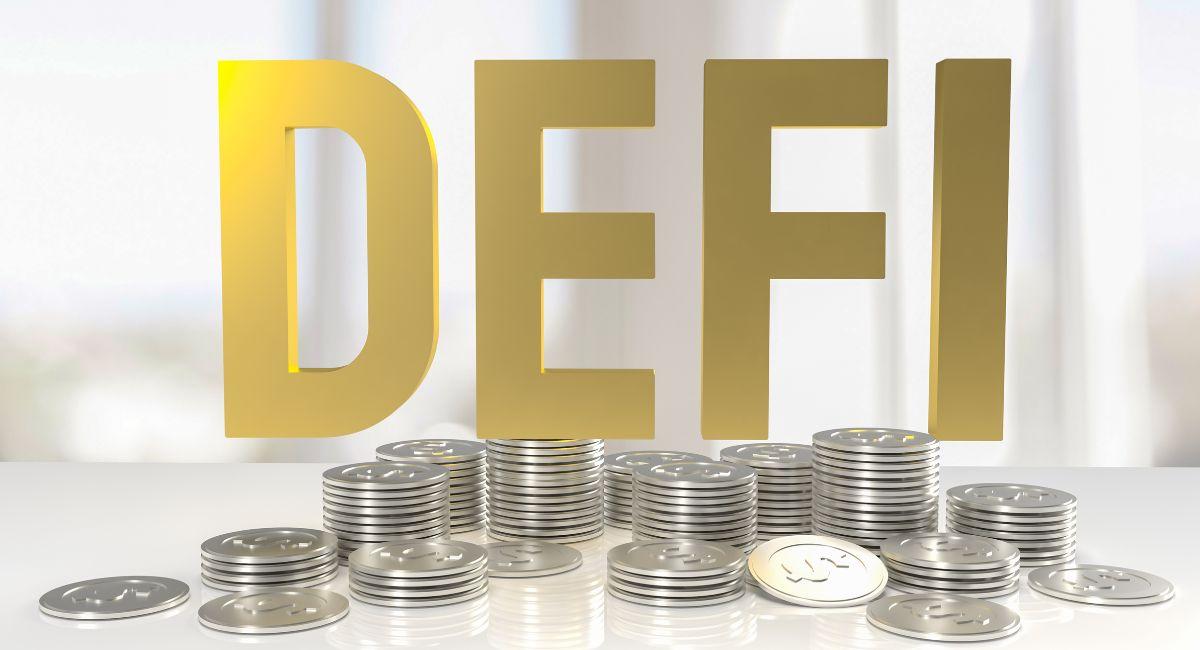Deciphering DeFi Inscriptions And It’s Significance In The Blockchain World

In the ever-evolving landscape of finance, the emergence of Decentralized Finance (DeFi) has ignited a paradigm shift, challenging traditional notions of banking and offering a decentralized alternative. At the core of this financial revolution lie intricate elements known as DeFi inscriptions – a cryptographic dance of data that not only defines the transactions within this decentralized ecosystem but also holds the key to unlocking the full potential of blockchain-based finance. This comprehensive exploration aims to unravel the mystery behind DeFi inscriptions, their importance, and the transformative impact they wield in the world of decentralized finance.
Decoding DeFi Inscriptions:

In the ever-expanding universe of Decentralized Finance (DeFi), where blockchain technology intertwines with financial services, the concept of “DeFi inscriptions” emerges as a crucial and intricate aspect. These inscriptions are not mere annotations on a ledger; they constitute the cryptographic backbone of DeFi, embodying the transactions, agreements, and interactions that define this decentralized ecosystem. This comprehensive exploration seeks to delve into the depths of DeFi inscriptions, unraveling their essence, significance, and the profound impact they have on reshaping the future of finance.
I. Defining DeFi Inscriptions: The Essence of Cryptographic Records
- Blockchain as the Immutable Ledger: At the heart of DeFi inscriptions lies the blockchain—a decentralized, distributed ledger that records transactions across a network of computers. In the context of DeFi, blockchain serves as the immutable ledger, capturing and safeguarding the details of financial activities through cryptographic inscriptions.
- Smart Contracts as the Architects of Inscriptions: Smart contracts, self-executing code deployed on the blockchain, serve as the architects of DeFi inscriptions. These programmable contracts encode the rules and conditions of financial agreements. When triggered by predefined conditions, smart contracts autonomously execute actions, resulting in inscriptions that chronicle each step of a financial transaction.
II. The Significance of DeFi Inscriptions: Unveiling Transparency and Trust
- Transparency as a Pillar: DeFi inscriptions play a pivotal role in instilling transparency within the decentralized financial ecosystem. Every transaction, be it lending, borrowing, swapping tokens, or participating in liquidity pools, is inscribed on the blockchain in a transparent and auditable manner.
- Immutable Record-Keeping: The immutability of blockchain ensures that once a DeFi inscription is made, it becomes an indelible part of the historical record. This immutability not only enhances the security of financial transactions but also provides a robust and unalterable audit trail, fostering trust in a trustless environment.
- Decentralization and Financial Inclusion: DeFi inscriptions epitomize the ethos of decentralization, eliminating the need for intermediaries. This decentralized nature empowers individuals globally, facilitating their participation in a borderless financial system. DeFi inscriptions break down geographical barriers, fostering financial inclusion.
- Smart Contract Automation for Efficiency: The programmability of smart contracts, and the subsequent inscriptions they generate, introduces a new era of automation in financial processes. DeFi inscriptions automate various aspects, from executing lending agreements to facilitating complex yield farming strategies, making financial interactions efficient and accessible.
The Crucial Significance of DeFi Inscriptions:

In the dynamic landscape of Decentralized Finance (DeFi), where traditional financial structures are being redefined through blockchain technology, the concept of “DeFi inscriptions” emerges as a linchpin in the transformative potential of decentralized finance. These inscriptions are not merely technicalities within the blockchain; they form the core fabric of trust, transparency, and efficiency that underpins the entire DeFi ecosystem. This extensive exploration aims to meticulously dissect and elucidate the profound significance of DeFi inscriptions, examining why they matter and how they are shaping the future of finance.
I. Transparency Unveiled:
- Immutable Ledger as a Pillar of Trust: DeFi inscriptions matter fundamentally because they provide an immutable and transparent record of financial transactions. Unlike traditional financial systems where records can be altered or manipulated, inscriptions on the blockchain are irrevocable, forming an incorruptible ledger of truth. This transparency is foundational to building trust in a decentralized environment.
- User-Driven Auditability: DeFi inscriptions enable anyone to independently audit and verify transactions. This user-driven auditability is a departure from the opaque nature of traditional financial systems, where individuals often have limited access to the inner workings of financial institutions. The transparency afforded by inscriptions empowers users with a level of visibility and accountability previously unseen.
II. Immutability as a Security Feature:
- Guardians of Financial Integrity: The immutability of DeFi inscriptions is a critical security feature. Once a transaction is inscribed on the blockchain, it becomes an indelible part of the historical record. This characteristic guards against fraud, tampering, or any malicious activities that could compromise the integrity of financial transactions. Immutability ensures the security of financial operations in a trustless and decentralized setting.
- Reliability in Record-Keeping: Traditional financial systems often grapple with the challenge of maintaining reliable records, leading to disputes and discrepancies. DeFi inscriptions, with their immutable nature, provide a reliable and permanent record-keeping mechanism. This not only enhances the security of financial transactions but also streamlines dispute resolution within the decentralized ecosystem.
III. Empowering Decentralization and Inclusion:
- Removal of Intermediaries: DeFi inscriptions play a pivotal role in the removal of intermediaries. Traditional financial systems are laden with intermediaries such as banks, clearinghouses, and custodians, introducing layers of complexity and cost. DeFi inscriptions facilitate direct peer-to-peer transactions, eliminating the need for intermediaries and fostering a decentralized financial infrastructure.
- Global Financial Inclusion: The decentralized nature of DeFi inscriptions transcends geographical boundaries, opening up financial opportunities to a global audience. Individuals who were previously excluded from traditional financial systems due to geographical constraints or lack of access to banking services can now participate in a borderless financial ecosystem.
IV. Efficiency through Automation:
- Smart Contracts as Inscription Enablers: DeFi inscriptions are intricately linked to the programmable nature of smart contracts. These self-executing agreements automatically execute predefined actions when conditions are met, generating inscriptions on the blockchain. This automation not only streamlines financial processes but also reduces the need for manual intervention, making DeFi operations more efficient.
- Real-Time Settlements: Traditional financial transactions often involve delays due to intermediaries, clearing processes, and time zone differences. DeFi inscriptions, facilitated by smart contracts, enable real-time settlements. Transactions are executed and recorded on the blockchain instantly, enhancing the speed and efficiency of financial interactions.
V. Diverse Inscriptions Reflecting DeFi Activities:
- Token Transfers: DeFi inscriptions cover a wide array of activities, starting with the fundamental movement of tokens. Each token transfer is inscribed on the blockchain, detailing the sender, receiver, and amount, providing a transparent and traceable history of transactions.
- Liquidity Pool Interactions: In the realm of decentralized exchanges and liquidity pools, inscriptions capture the dynamic interactions between participants. These inscriptions reflect the movement of assets within pools, influencing liquidity, and shaping market dynamics.
- Borrowing and Lending Activities: DeFi lending protocols generate inscriptions when users engage in borrowing or lending activities. These inscriptions encapsulate details such as loan terms, interest rates, and collateral information, creating a transparent and auditable record of financial agreements.
Exploring Types of DeFi Inscriptions:

In the intricate realm of Decentralized Finance (DeFi), the concept of “DeFi inscriptions” is not a monolithic entity but a dynamic and multifaceted construct. These inscriptions, etched onto the blockchain, go beyond being mere records; they encapsulate a myriad of financial activities, each telling a unique story of decentralized interactions. This detailed exploration seeks to unravel the diverse types of DeFi inscriptions, delving into the nuances of token transfers, liquidity pool interactions, and borrowing/lending activities that collectively shape the rich tapestry of decentralized finance.
I. Token Transfers: The Fundamental Inscription:
- The Genesis of Inscriptions: At the heart of DeFi inscriptions lies the fundamental movement of tokens. Each token transfer is an inscription on the blockchain, recording the transfer of value from one address to another. This basic yet pivotal form of inscription provides a transparent and auditable history of transactions within the decentralized ecosystem.
- Details Encapsulated: The inscription of token transfers includes essential details such as the sender’s address, the recipient’s address, the amount of tokens transferred, and a timestamp. These inscriptions form the building blocks of transparency and traceability within the DeFi landscape, allowing users to verify and validate each transaction.
II. Liquidity Pool Interactions: Navigating the Dynamic Terrain:
- The Nexus of Trading Pools: In the decentralized exchange and liquidity pool ecosystem, inscriptions capture the dynamic interactions between participants. Liquidity pool interactions involve the provision of assets to pools, contributing to market liquidity, and the execution of trades within these pools.
- Influencing Liquidity Dynamics: Liquidity pool inscriptions include details such as the assets contributed, transaction volumes, and changes in pool balances. These inscriptions reflect the ebb and flow of assets within the liquidity pool, influencing liquidity dynamics and shaping the overall market environment.
III. Borrowing and Lending Activities: Crafting Financial Agreements:
- DeFi Lending Protocols: DeFi lending platforms generate inscriptions when users engage in borrowing or lending activities. These inscriptions encapsulate the terms of the loan, interest rates, collateral details, and other pertinent information, creating a transparent and auditable record of financial agreements.
- Transparent Financial Agreements: The inscriptions related to borrowing and lending activities provide a clear and detailed account of financial agreements within the DeFi ecosystem. Users can trace the origin of loans, monitor interest accrual, and verify the collateralization of assets through these inscriptions.
IV. Yield Farming and Staking: Cultivating Inscriptions for Rewards:
- Yield Farming Strategies: Yield farming involves users providing liquidity to decentralized protocols in exchange for rewards. The inscriptions in this context detail the participation in liquidity pools, the staking of assets, and the accumulation of rewards offered by DeFi protocols.
- Staking and Inscriptions: Staking inscriptions revolve around users locking their tokens in smart contracts to support the security and functionality of blockchain networks. These inscriptions capture the staking activities, including the duration of the stake, the amount staked, and the corresponding rewards.
V. Governance Participation: Shaping the Future through Inscriptions:
- Participation in Governance Proposals: Governance tokens in DeFi empower users to participate in the decision-making processes of protocols. Inscriptions related to governance participation encompass activities such as voting on proposals, suggesting changes to protocol parameters, and influencing the direction of decentralized platforms.
- Insight into Protocol Evolution: Governance inscriptions provide insights into the evolution of DeFi protocols. Users can trace the history of governance decisions, assess the voting patterns of participants, and understand the collective decisions that shape the future trajectory of decentralized platforms.
VI. Derivatives and Complex Financial Instruments: Navigating Inscriptions in a Sophisticated Landscape:
- Insuring Against Price Volatility: DeFi platforms offer derivatives and complex financial instruments that enable users to hedge against price volatility. Inscriptions in this domain capture transactions related to options, futures, and other derivative instruments, providing a transparent record of risk management strategies.
- Risk Management Inscriptions: DeFi inscriptions related to derivatives include details about the terms of derivative contracts, premium payments, and settlements. These inscriptions enable users to track risk management activities and understand the strategies employed to navigate the complex world of decentralized derivatives.
💢 @eobotech aims to be a a user friendly #DeFi toolkit
💢 #EOBO is powered by the utility token $EOBO
✨ Introduces farmpad
✨ Self-balancing Earn & Burn mechanism
✨Support staking activities🔽 VISIThttps://t.co/cTjCZDa0SZ#Definews pic.twitter.com/y2t1M9yIUn
— 🌐 𝐃𝐄𝐅𝐈 𝐍𝐄𝐖𝐒 🌐 (@Definews_Info) January 3, 2024
The Challenges and Future Evolution of DeFi Inscriptions

In the ever-evolving landscape of Decentralized Finance (DeFi), the journey of DeFi inscriptions is not without challenges. As these cryptographic records weave through the decentralized tapestry, challenges emerge, and the future evolution of DeFi inscriptions requires a strategic and innovative approach. This comprehensive exploration delves into the challenges faced by DeFi inscriptions and envisages the future trajectory of this critical component, culminating in a robust conclusion that reflects the transformative potential and resilience of decentralized finance.
I. Scalability Challenges: Paving the Way for Mass Adoption
- Exponential Growth and Network Congestion: The meteoric rise of DeFi has led to an unprecedented surge in transaction volumes, causing network congestion on popular blockchain platforms. As a result, scalability challenges surface, impacting transaction speeds and the cost-effectiveness of DeFi inscriptions.
- Addressing Scalability Through Layer 2 Solutions: To overcome scalability hurdles, the DeFi ecosystem is exploring Layer 2 solutions. These solutions, such as sidechains and rollups, aim to process a significant portion of transactions off the main blockchain, reducing congestion and enhancing the scalability of DeFi inscriptions.
II. Privacy Considerations: Balancing Transparency and User Privacy
- Transparent Yet Private Transactions: While transparency is a fundamental tenet of DeFi inscriptions, there is a growing recognition of the need to balance this transparency with user privacy. Traditional blockchain networks expose transaction details to all participants, raising concerns about the confidentiality of financial activities.
- Innovations in Privacy-Focused Cryptography: Innovations in privacy-focused cryptography, such as Zero-Knowledge Proofs (ZKPs) and ring signatures, are gaining prominence. These techniques allow users to engage in private transactions while still benefiting from the security and transparency offered by DeFi inscriptions.
III. Interoperability Across Blockchains: Bridging the Divide
- Fragmentation and Interoperability Challenges: The decentralized landscape is marked by the coexistence of various blockchain networks, each with its own set of protocols and standards. Achieving interoperability, where DeFi inscriptions seamlessly traverse different blockchains, becomes a critical challenge due to the lack of standardized communication protocols.
- Advancements in Cross-Chain Solutions: Cross-chain solutions and interoperability protocols are emerging to address the challenges of fragmentation. These solutions aim to create bridges that facilitate the movement of assets and inscriptions across diverse blockchain networks, fostering a more interconnected and collaborative DeFi ecosystem.
IV. Regulatory Dynamics: Navigating Compliance in a Decentralized World
- Regulatory Compliance Challenges: The decentralized and pseudonymous nature of DeFi inscriptions poses challenges in adhering to traditional financial regulations. Regulators seek to define and enforce compliance standards, raising questions about how DeFi platforms can align with regulatory requirements without compromising their decentralized ethos.
- The Quest for Regulatory Clarity: The future evolution of DeFi inscriptions is closely tied to the establishment of regulatory frameworks. As the regulatory landscape evolves, there is a growing need for clear guidelines that strike a balance between fostering innovation and ensuring the protection of users in the decentralized financial space.
V. Security Concerns: Safeguarding the Foundations of DeFi
- Smart Contract Vulnerabilities: DeFi inscriptions heavily rely on smart contracts to execute transactions and agreements. However, vulnerabilities in smart contract code can be exploited, leading to security breaches and financial losses for users.
- Advancements in Security Audits and Protocols: The future evolution of DeFi inscriptions necessitates advancements in security measures. Rigorous smart contract audits, the development of standardized security protocols, and the integration of AI-driven security solutions are pivotal to fortifying the foundations of decentralized finance.
Also, read- The Role Of Crypto Payment Gateways In Decentralized Finance (DeFi)
Conclusion: Navigating the Future with Resilience and Innovation
In conclusion, the challenges faced by DeFi inscriptions are not roadblocks but opportunities for innovation and growth. The future evolution of decentralized finance hinges on the resilience of the community to address scalability, privacy, interoperability, regulatory, and security challenges. As DeFi inscriptions continue to script the narrative of a decentralized financial future, the fusion of technological advancements, regulatory clarity, and a commitment to financial inclusion will pave the way for a robust and inclusive decentralized ecosystem. The challenges encountered are not impediments but milestones in the journey toward a decentralized tomorrow where the power of finance is truly in the hands of the people.


























































